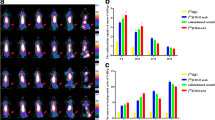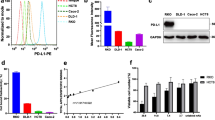Abstract
Purpose
We examined the possible efficacy of the yttrium-90 (90Y)-labeled anti-CDH3/P-cadherin mouse monoclonal antibody (MAb-6) in radioimmunotherapy (RIT) for lung and colorectal cancers that express CDH3/P-cadherin.
Experimental design
MAb-6 was established using genetic immunization. The biodistribution of MAb-6 in nude mice with lung and colorectal cancers was examined by administering indium-111(111In)-labeled MAb-6 to mice. The mice were prepared by inoculation of CDH3/P-cadherin-positive (EBC1, H1373, and SW948) and CDH3/P-cadherin-negative (A549 and RKO) tumor cells. Therapeutic effects and toxicity were investigated by administration of 90Y-labeled MAb-6 (90Y-MAb-6) to EBC, H1373, and SW948-inoculated mice.
Results
Our in vivo results confirmed the specific binding of MAb-6 to tumor cells after intravenous injections of 111In-labeled MAb-6 to mice with tumors expressing CDH3/P-cadherin. A single intravenous injection of 90Y-MAb-6 (100 μCi) significantly suppressed tumor growth in mice with tumors expressing CDH3/P-cadherin. Furthermore, two injections of 90Y-MAb-6 led to complete tumor regression in H1373-inoculated mice without any detectable toxicity.
Conclusions
Our findings demonstrate that CDH3/P-cadherin-targeting RIT with 90Y-MAb-6 is a promising strategy for the treatment for cancers expressing CDH3/P-cadherin.




Similar content being viewed by others
References
Maloney DG, Grillo-López AJ, White CA et al (1997) IDEC-C2B8 (Rituximab) anti-CD20 monoclonal antibody therapy in patients with relapsed low-grade non-Hodgkin’s lymphoma. Blood 90:2188–2195
McNeil C (1998) Herceptin raises its sights beyond advanced breast cancer. J Natl Cancer Inst 90:882–883
Chen HX, Gore-Langton RE, Cheson BD (2001) Clinical trials referral resource: current clinical trials of the anti-VEGF monoclonal antibody bevacizumab. Oncology (Williston Park) 15:1017, 1020, 1023–1026
Baselga J (2001) The EGFR as a target for anticancer therapy-focus on cetuximab. Eur J Cancer 37(Suppl 4):S16–S22
Grossbard ML, Press OW, Appelbaum FR, Bernstein ID, Nadler LM (1992) Monoclonal antibody-based therapies of leukemia and lymphoma. Blood 80:863–878
Palanca-Wessels MC, Press OW (2010) Improving the efficacy of radioimmunotherapy for non-Hodgkin lymphomas. Cancer 116:1126–1133
Jain M, Venkatraman G, Batra SK (2007) Optimization of radioimmunotherapy of solid tumors: biological impediments and their modulation. Clin Cancer Res 13:1374–1382
Bischof DA (2003) The role of nuclear medicine in the treatment of non-Hodgkin’s lymphoma (NHL). Leuk Lymphoma 44(Suppl 4):S29–S36
Chinn P, Braslawsky G, White C, Hanna N (2003) Antibody therapy of non-Hodgkin’s B-cell lymphoma. Cancer Immunol Immunother 52:257–280
Nakamura T, Furukawa Y, Nakagawa H et al (2004) Genome-wide cDNA microarray analysis of gene expression profiles in pancreatic cancers using populations of tumor cells and normal ductal epithelial cells selected for purity by laser microdissection. Oncogene 23:2385–2400
Hasegawa S, Furukawa Y, Li M et al (2002) Genome-wide analysis of gene expression in intestinal-type gastric cancers using a complementary DNA microarray representing 23, 040 genes. Cancer Res 62:7012–7017
Lin YM, Furukawa Y, Tsunoda T, Yue CT, Yang KC, Nakamura Y (2002) Molecular diagnosis of colorectal tumors by expression profiles of 50 genes expressed differentially in adenomas and carcinomas. Oncogene 21:4120–4128
Kikuchi T, Daigo Y, Katagiri T et al (2003) Expression profiles of non-small cell lung cancers on cDNA microarrays: identification of genes for prediction of lymph-node metastasis and sensitivity to anti-cancer drugs. Oncogene 22:2192–2205
Takata R, Katagiri T, Kanehira M et al (2005) Predicting response to methotrexate, vinblastine, doxorubicin, and cisplatin neoadjuvant chemotherapy for bladder cancers through genome-wide gene expression profiling. Clin Cancer Res 11:2625–2636
Imai K, Hirata S, Irie A et al (2008) Identification of a novel tumor-associated antigen, cadherin 3/P-cadherin, as a possible target for immunotherapy of pancreatic, gastric, and colorectal cancers. Clin Cancer Res 14:6487–6495
Paredes J, Correia AL, Ribeiro AS, Albergaria A, Milanezi F, Schmitt FC (2007) P-cadherin expression in breast cancer: a review. Breast Cancer Res 9:214
Taniuchi K, Nakagawa H, Hosokawa M et al (2005) Overexpressed P-cadherin/CDH3 promotes motility of pancreatic cancer cells by interacting with p120ctn and activating rho-family GTPases. Cancer Res 65:3092–3099
Tang DC, De Vit M, Johnston SA (1992) Genetic immunization is a simple method for eliciting an immune response. Nature 356:152–154
Fukukawa C, Hanaoka H, Nagayama S et al (2008) Radioimmunotherapy of human synovial sarcoma using a monoclonal antibody against FZD10. Cancer Sci 99:432–440
Chinn PC, Leonard JE, Rosenberg J, Hanna N, Anderson DR (1999) Preclinical evaluation of 90Y-labeled anti-CD20 monoclonal antibody for treatment of non-Hodgkin’s lymphoma. Int J Oncol 15:1017–1025
Wheelock MJ, Johnson KR (2003) Cadherins as modulators of cellular phenotype. Annu Rev Cell Dev Biol 19:207–235
Takeichi M (1988) The cadherins: cell-cell adhesion molecules controlling animal morphogenesis. Development 102:639–655
Nose A, Takeichi M (1986) A novel cadherin cell adhesion molecule: its expression patterns associated with implantation and organogenesis of mouse embryos. J Cell Biol 103:2649–2658
Jain RK, Baxter LT (1988) Mechanisms of heterogeneous distribution of monoclonal antibodies and other macromolecules in tumors: significance of elevated interstitial pressure. Cancer Res 48:7022–7032
Motta-Hennessy C, Sharkey RM, Goldenberg DM (1990) Metabolism of indium-111-labeled murine monoclonal antibody in tumor and normal tissue of the athymic mouse. J Nucl Med 31:1510–1519
Duncan JR, Welch MJ (1993) Intracellular metabolism of indium-111-DTPA-labeled receptor targeted proteins. J Nucl Med 34:1728–1738
Franano FN, Edwards WB, Welch MJ, Duncan JR (1994) Metabolism of receptor targeted 111In-DTPA-glycoproteins: identification of 111In-DTPA-epsilon-lysine as the primary metabolic and excretory product. Nucl Med Biol 21:1023–1034
Sharkey RM, Blumenthal RD, Behr TM, Wong GY, Haywood L et al (1997) Selection of radioimmunoconjugates for the therapy of well-established or micrometastatic colon carcinoma. Int J Cancer 29:477–485
Behr TM, Sgouros G, Stabin MG, Béhé M, Angerstein C et al (1999) Studies on the red marrow dosimetry in radioimmunotherapy: an experimental investigation of factors influencing the radiation-induced myelotoxicity in therapy with β-, auger/conversion electron-, or α-emitters. Clin Cancer Res 5:3031s–3043s
Esteban JM, Hyams DM, Beatty BG, Merchant B, Beatty JD (1990) Radioimmunotherapy of human colon carcinomatosis xenograft with 90Y-ZCE025 monoclonal antibody: toxicity and tumor phenotype studies. Cancer Res 50:989s–992s
Zhang CC, Yan Z, Zhang Q et al (2010) PF-03732010: a fully human monoclonal antibody against P-cadherin with antitumor and antimetastatic activity. Clin Cancer Res 16:5177–5188
Acknowledgments
We would like to thank Dr. Megumi Takayanagi for contributions to this project. This study was funded by Oncotherapy Science Inc.
Conflict of interest
The authors declare that they have no conflicts of interest.
Author information
Authors and Affiliations
Corresponding author
Electronic supplementary material
Below is the link to the electronic supplementary material.
Rights and permissions
About this article
Cite this article
Yoshioka, H., Yamamoto, S., Hanaoka, H. et al. In vivo therapeutic effect of CDH3/P-cadherin-targeting radioimmunotherapy. Cancer Immunol Immunother 61, 1211–1220 (2012). https://doi.org/10.1007/s00262-011-1186-0
Received:
Accepted:
Published:
Issue Date:
DOI: https://doi.org/10.1007/s00262-011-1186-0




